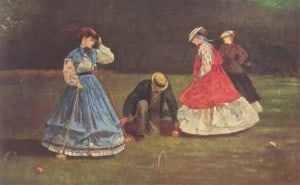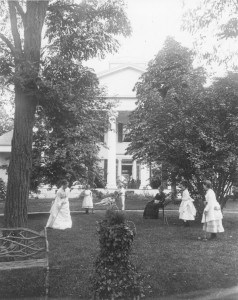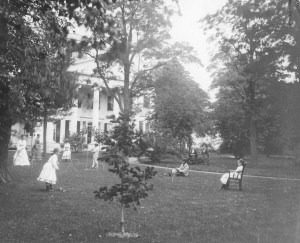Croquet
By Alice Askins, Site Manager at Rose Hill
The game of croquet was wildly popular in the 1860s and early 1870s. It was popular that it figured (in fantasy form) in Alice in Wonderland, published in 1865. The craze began in Britain and soon spread to other English-speaking countries. However, the origin of croquet is cloudy. According to Wikipedia, the game derives from ground billiards, popular in Western Europe since the 14th century, with roots in classical antiquity.
By the late 1870s, croquet had been largely replaced by another fashionable game, tennis. Many of the newly-created croquet clubs, including the All England club at Wimbledon, converted some or all of their lawns into tennis courts. There was a croquet revival in the 1890s, and again between the 1920s and 40s. In the latter period, croquet was a favorite pastime of famous entertainment and literary figures. Harpo Marx, for example, talked about an extreme form of the game in his autobiography. Extreme croquet is still with us – a variation distinguished by adventurous conditions of play.
Backyard croquet has maintained a presence in the United States America for over a hundred and forty years, as the ideal complement of garden parties, family gatherings, outdoor fund-raisers, and picnics. There is a U. S. Croquet Association, and there are several Extreme Croquet groups.
I have not found any references to croquet in Geneva newspapers from the 1860s, but in September of 1868, the Brooklyn Daily Eagle said, ‘People brag of croquet as a successful new amusement—”It brings young people together, you know.”’ Bringing young people together, while frowned on by some, was significant. Croquet was one of the first outdoor games that men and women played together, and it gave them opportunities to talk together in relative privacy. The local papers carried several stories and poems about romance among the wickets – some humorous, some serious. As the Courierput it in April of 1877, “The proprietors of croquet grounds are preparing for the spring and summer . . . and many will be . . . the matches made.” Matches made, as opposed to matches played, is a reference to courtship.
Croquet, though, had its dark side. Women were widely assumed to cheat by moving the balls under their skirts. In 1875, the Geneva Gazetteprinted a fictional story of a devoted married couple who got into a terrible argument over the game; it ended with the wife telling her husband to shove his mallet down his throat and choke on it. The Gazette referred in 1899 to croquet’s “devastating effect on the temper, its known tendency to break up happy homes and destroy the friendships of years. . . . the rules are numerous, and new points are continually coming up, so that interested players often discuss the rules and dispute the interpretation with as much vehemence as baseball players in their quarrels with the umpires.”
As the Daily Times explained it in 1899, “Students of human nature can get a great deal of quiet pleasure out of the game. The honest and dishonest natures will assert themselves, just as surely as in poker. The quarrelsome and peaceful dispositions also show themselves. One cannot always tell on the croquet field whom to marry, but it is not hard to tell whom one should not marry.”
The Oswego Daily Times tells us in 1873 about the Moral Discipline of Croquet. “[Croquet] is a severe test of Christian principle . . . a rare test of character. We have played with men whose high position warranted us in expecting the utmost honorableness and fair dealing. But croquet was too great a strain upon their moral natures – the weakness of their characters revealed itself. We remember a college president who could not help stopping his ball in the most accidental fashion when it was likely to roll too far. We know fair ladies who, in a closely-contested game, always happen to dislocate their balls with their dress skirts, who then claim every advantage in replacing them. What shall we say of such people? That their honesty of character will not stand croquet – will not stand any of the severe tests to which the emulations of life subject them.”
Despite the moral pitfalls, people continued to play croquet. Even in the 1880s, when the game is supposed to have been in temporary eclipse, we find an advertisement in the Geneva Advertiser (May 1887) for Winnie’s China Hall at 204 Exchange Streetselling croquet sets. It was, after all, also “a game for all ages, and an enthusiast of rising eighty may play all day with an amateur of eight.” (Geneva Gazette August 4, 1899) The definitive word on the subject came early. In 1878 the Courier printed an account of a trip from Genevato the Antrim coal mines in Tioga County – “For a little the Tioga river bears us company, and then we leave it to ascend the long ridge that lies between us and Antrim. . . .The country grows rougher . . . the buildings are rude and unpainted; yet the inhabitants are not uncivilized. They play croquet.”



